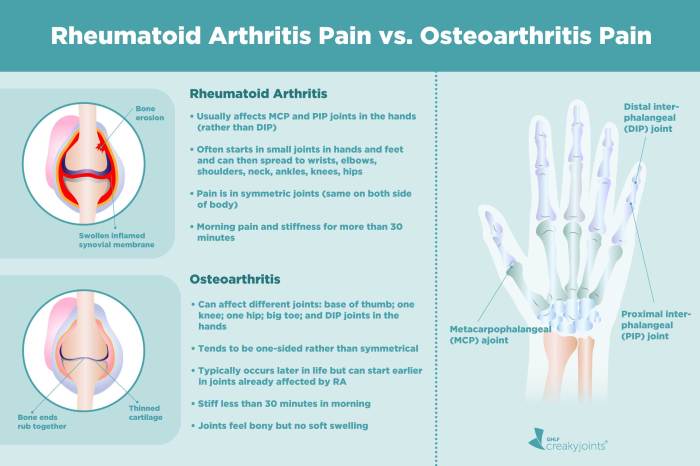The nurse understands that which information is correct about osteoarthritis, a prevalent condition affecting millions worldwide. This comprehensive guide explores the intricacies of osteoarthritis, empowering nurses with the knowledge to effectively educate patients and guide them towards optimal outcomes.
Osteoarthritis, a degenerative joint disease, arises from the breakdown of cartilage, the protective tissue cushioning our joints. This breakdown leads to pain, stiffness, and reduced mobility, significantly impacting individuals’ quality of life. Understanding the nature of osteoarthritis is paramount for nurses in providing informed care and support.
Osteoarthritis: General Overview

Osteoarthritis is a degenerative joint disease that affects millions of people worldwide. It is characterized by the breakdown of cartilage, the protective tissue that covers the ends of bones in joints. Osteoarthritis can occur in any joint, but it most commonly affects the knees, hips, spine, and hands.
Understanding Cartilage: The Nurse Understands That Which Information Is Correct About Osteoarthritis

Cartilage is a specialized connective tissue that provides cushioning and support to joints. It is composed of cells called chondrocytes, which are embedded in a matrix of collagen and other proteins. In osteoarthritis, the chondrocytes become less active and produce less collagen, leading to the breakdown of cartilage.
Risk Factors and Prevention
Osteoarthritis is a complex disease with multiple risk factors, including:
- Age
- Obesity
- Joint injury
- Family history
- Certain occupations and sports
While some risk factors cannot be modified, others can be managed to reduce the risk of developing osteoarthritis or slow its progression. For example, maintaining a healthy weight, engaging in regular exercise, and avoiding joint injuries can all help to protect joints.
Diagnosis and Assessment
Osteoarthritis is typically diagnosed based on a physical examination and a patient’s medical history. X-rays can be used to confirm the diagnosis and assess the severity of the disease. Other imaging techniques, such as magnetic resonance imaging (MRI) and computed tomography (CT), may also be used to evaluate the extent of cartilage damage and other joint abnormalities.
Treatment Options, The nurse understands that which information is correct about osteoarthritis
There is no cure for osteoarthritis, but there are a variety of treatments available to manage the symptoms and improve joint function. These include:
- Medications (e.g., pain relievers, anti-inflammatories, disease-modifying antirheumatic drugs)
- Physical therapy
- Occupational therapy
- Assistive devices (e.g., canes, walkers, wheelchairs)
- Surgery (in severe cases)
The choice of treatment will depend on the severity of the disease, the patient’s age and overall health, and their individual preferences.
Role of Nurses in Osteoarthritis Management
Nurses play a vital role in the management of osteoarthritis. They can:
- Educate patients about osteoarthritis and its treatment options
- Provide support and counseling to patients
- Help patients develop self-management strategies
- Monitor patients’ progress and adjust treatment plans as needed
- Advocate for patients’ needs
Advanced Therapies and Research
Research into new treatments for osteoarthritis is ongoing. Some promising areas of research include:
- Regenerative medicine (e.g., stem cell therapy)
- Gene therapy
- Nanotechnology
These therapies have the potential to slow the progression of osteoarthritis or even reverse the damage that has been done. However, more research is needed to confirm their effectiveness and safety.
Detailed FAQs
What are the common symptoms of osteoarthritis?
Osteoarthritis typically manifests as joint pain, stiffness, swelling, and reduced range of motion.
What are the risk factors for developing osteoarthritis?
Age, obesity, joint injury, and family history are all considered risk factors for osteoarthritis.
What are the treatment options for osteoarthritis?
Treatment options for osteoarthritis include pain relievers, physical therapy, injections, and in severe cases, joint replacement surgery.

